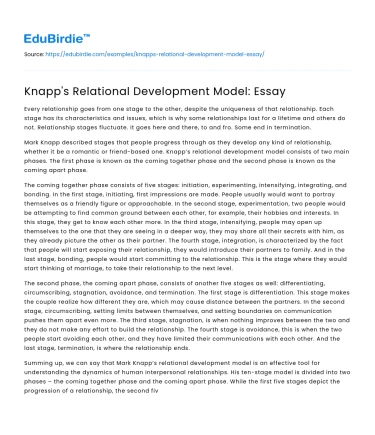Every relationship goes from one stage to the other, despite the uniqueness of that relationship. Each stage has its characteristics and issues, which is why some relationships last for a lifetime and others do not. Relationship stages fluctuate. It goes here and there, to and fro. Some end in termination.
Mark Knapp described stages that people progress through as they develop any kind of relationship, whether it be a romantic or friend-based one. Knapp’s relational development model consists of two main phases. The first phase is known as the coming together phase and the second phase is known as the coming apart phase.
Save your time!
We can take care of your essay
- Proper editing and formatting
- Free revision, title page, and bibliography
- Flexible prices and money-back guarantee
The coming together phase consists of five stages: initiation, experimenting, intensifying, integrating, and bonding. In the first stage, initiating, first impressions are made. People usually would want to portray themselves as a friendly figure or approachable. In the second stage, experimentation, two people would be attempting to find common ground between each other, for example, their hobbies and interests. In this stage, they get to know each other more. In the third stage, intensifying, people may open up themselves to the one that they are seeing in a deeper way, they may share all their secrets with him, as they already picture the other as their partner. The fourth stage, integration, is characterized by the fact that people will start exposing their relationship, they would introduce their partners to family. And in the last stage, bonding, people would start committing to the relationship. This is the stage where they would start thinking of marriage, to take their relationship to the next level.
The second phase, the coming apart phase, consists of another five stages as well: differentiating, circumscribing, stagnation, avoidance, and termination. The first stage is differentiation. This stage makes the couple realize how different they are, which may cause distance between the partners. In the second stage, circumscribing, setting limits between themselves, and setting boundaries on communication pushes them apart even more. The third stage, stagnation, is when nothing improves between the two and they do not make any effort to build the relationship. The fourth stage is avoidance, this is when the two people start avoiding each other, and they have limited their communications with each other. And the last stage, termination, is where the relationship ends.
Summing up, we can say that Mark Knapp’s relational development model is an effective tool for understanding the dynamics of human interpersonal relationships. His ten-stage model is divided into two phases – the coming together phase and the coming apart phase. While the first five stages depict the progression of a relationship, the second five stages represent its deterioration.






 Stuck on your essay?
Stuck on your essay?

